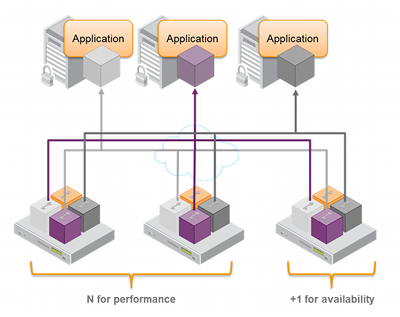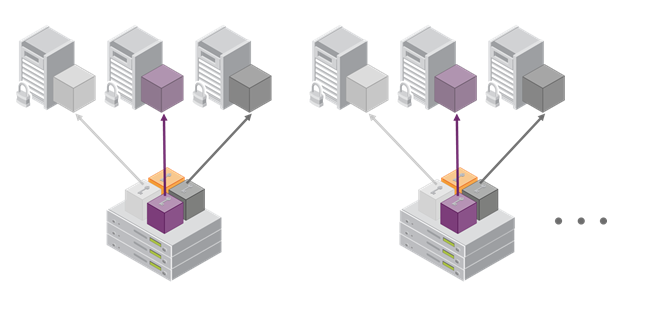
|
Home > |
Administration Guide > High-Availability (HA) Configuration and Operation > Planning Your Deployment
|
|---|
This section describes the supported configurations and any limitations or constraints to consider when setting up an HA group.
It is important that all members in an HA group have the same configuration and version. That means that each HA group member must use the same authentication method, either PED-authenticated or password-authenticated, and be at the same software version. Running HA groups with different versions is unsupported. Ensure that HSMs are configured identically to ensure smooth high availability and load balancing operation. SafeNet HSMs come with various key management configurations: cloning mode, key-export mode, etc. HA functionality is supported with both cloning and SIM variants – provided all members in the group have the same configuration. Clients automatically and transparently use the correct secure key replication method based on the group’s configuration.
It is also critical that all members in an HA group share the same Security Domain role (Red PED key for PED-authenticated devices, or domain password for password-authenticated devices). The Security Domain defines which HSMs are allowed to share key material. Because HA group members are, by definition, intended to be peers, they must be in the same Security Domain.
The SafeNet HA and load-balancing feature works on a per-client and per-partition bases. This provides a lot of flexibility. For example, it is possible to define a different sub-set of HSMs in each client and even in each client’s partitions (in the event that a single client uses multiple partitions). SafeNet recommends to avoid these complex configurations and to keep the HA topography uniform for an entire HSM. That is, treat HSM members at the HSM level as atomic and whole. This simplifies the configuration management associated with the HA feature.
All SafeNet Network HSM appliances in an HA group must be at the same revision level. If you have SafeNet Network HSM units at different version levels, perform updates as necessary, before attempting to create an HA group -this applies to the system software version, not to the HSM firmware, which can differ among group members.
Generally, keep all HA members at the same firmware version. As well, all members should have the same optional capability updates applied. If mismatches are permitted among members, synchronization might be disrupted if your application attempts to use a mechanism or a capability that not all members support. In the previous section, we indicate that HSM firmware can differ between members of an HA group, but this is not intended for ongoing operation; rather, it allows you to keep all members within a group while you individually update their firmware, to ensure minimal disruption during the updates.
While it is possible to have HSMs with different firmware versions within an HA group, this is not generally recommended. Be aware that the capability of the group (in terms of features and available algorithms) is that of the member with the oldest firmware.
For example, if you had an HA group that included HSMs with two different firmware versions, then certain capabilities that are part of the newer firmware would be unavailable to Clients connecting to the HA group. Specifically, operations that make use of newer cryptographic mechanisms and algorithms would likely fail. The client's calls might be initially assigned to a newer-firmware HSM and could therefore appear to work for a time, but if the task was load-balanced to an HSM that did not support the newer features it would fail. Similarly, if the newer-firmware HSM dropped out of the group, operations would fail. Your Clients must not invoke those algorithms because not every member of the group supports them. The solution is to upgrade the older units to the most recent firmware and software versions (where possible) or else to limit clients to only the lowest supported feature set.
In any one HA group, always ensure that member partitions or member PKI tokens (USB-attached SafeNet USB HSMs, or SafeNet CA4/PCM token HSMs in a USB-attached SafeNet DOCK2 card reader) are on different / separate appliances. Do not attempt to include more than one HSM partition or PKI token (nor one of each) from the same appliance in a single HA group. This is not a supported configuration. Allowing two partitions from one HSM, or a partition from the HSM and an attached HSM (as for PKI), into a single HA group would defeat the purpose of HA by making the SafeNet appliance a potential single-point-of-failure.
SIM replication is supported. HA will work, but key replication must be performed manually, that is, key creation in such an environment will fail to replicate.
This configuration is supported, although you cannot clone/replicate private keys.
As of SafeNet HSM release 6.x, the high availability function supports the grouping of up to thirty-two members. However, the maximum practical group size for your application is driven by a trade-off between performance and the cost of replicating key material across the entire group. A common practice is to set the group size to N+1 where N is defined by the desired performance per application server(s). As depicted below, this solution gives the desired performance with a single extra HSM providing the availability requirement. The number of HSMs per group of application servers varies based on the application use case but, as depicted, groups of three are typical.

As performance needs grow beyond the performance capacity of three HSMs, it often makes sense to define a second independent group of application servers and HSMs to further isolate applications from any single point of failure. This has the added advantage of facilitating the distribution of HSM and application sets in different data centers.

The network topography of the HA group is generally not important to the proper functioning of the group. As long as the client has a network path to each member the HA logic will function. Keep in mind that having a varying range of latencies between the client and each HA member causes a command scheduling bias towards the low-latency members. It also implies that commands scheduled on the long-latency devices have a larger overall latency associated with each command. In this case, the command latency is a characteristic of the network; to achieve uniform load distribution ensure that latencies to each device in the group are similar (or use standby mode). Gigabit Ethernet network connections are recommended.
For SafeNet Network HSM HA function we suggest that all SafeNet Network HSM appliances in an HA group be at the same appliance software and firmware level. The issue is not about firmware level, per se - what might happen is that a newer firmware could contain newer algorithms that are not supported in the replaced firmware. If your client is configured to take advantage of newer/better algorithms when they become available, it might do so while one member of an HA group has new firmware, but another member has not yet been updated, and therefore does not yet support the requested algorithm. The client might not be able to interpret the resulting imbalance. Therefore, when you intend to upgrade/update any of the SafeNet Network HSM units in an HA group, or when you intend to upgrade/update the SafeNet Network HSM Client software, you might schedule some downtime for your application, if you anticipate a problem.
If the application is so critical that you cannot permit that much scheduled downtime, then you can set up a second complete set of Client computer and associated HA group. One set can service the application load while the other set is being upgraded or otherwise maintained. For such up-time-critical applications, you might already have such a backup set of Client-plus-HA-group that you would rotate in and out of service during regular maintenance windows.